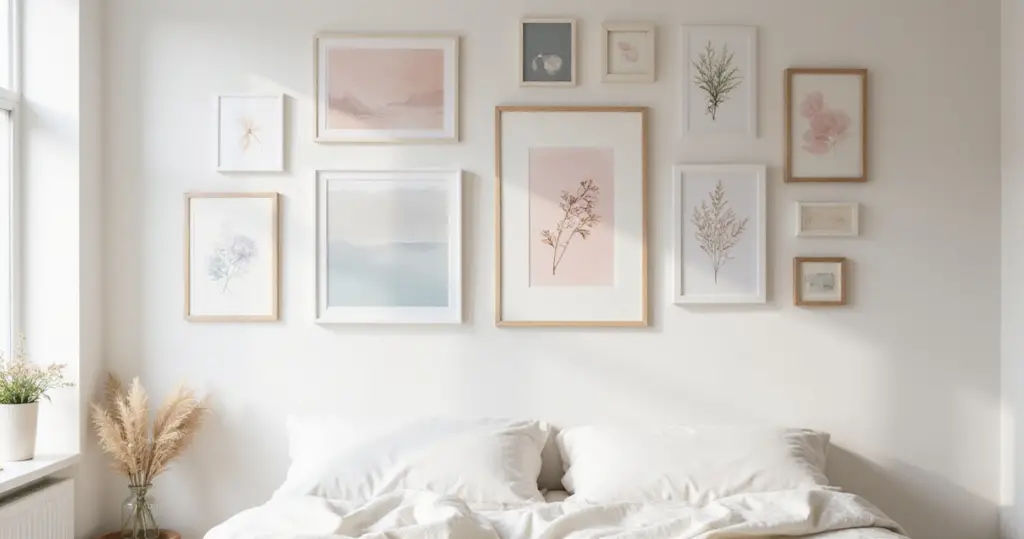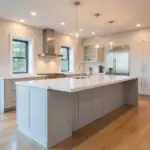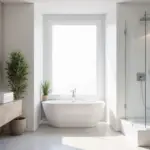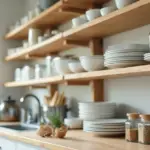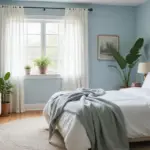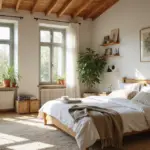Your bedroom isn’t merely a place for sleep—it’s your personal sanctuary, a retreat from the world’s chaos, and a space where you can truly unwind. And nothing transforms a room quite like thoughtfully chosen art. The right pieces can set the mood, reflect your personality, and turn a simple space into a curated haven.
Creating your ideal bedroom art aesthetic isn’t about following rigid rules or spending extravagantly. It’s about understanding how different types of art, display methods, and placement strategies work together to create a cohesive environment that feels uniquely yours. Whether you’re starting with bare walls or refreshing your existing decor, these 19 ideas offer practical ways to infuse style, personality, and tranquility through the power of art.
1. Crafting a Dreamy Gallery Wall Arrangement
A gallery wall in the bedroom becomes a deeply personal expression, evoking calm and dreaminess through careful selection. This feeling emerges from pieces sharing soft, muted color palettes—gentle pastels, soothing neutrals, or delicate blues and greens. The subject matter tends toward the ethereal: abstract landscapes, celestial motifs, or botanical prints. The magic happens when you mix materials, blending framed prints with woven hangings, small mirrors, or sculptural elements that add visual softness. Rather than rigid symmetry, an organic, slightly asymmetrical layout enhances the tranquil atmosphere.
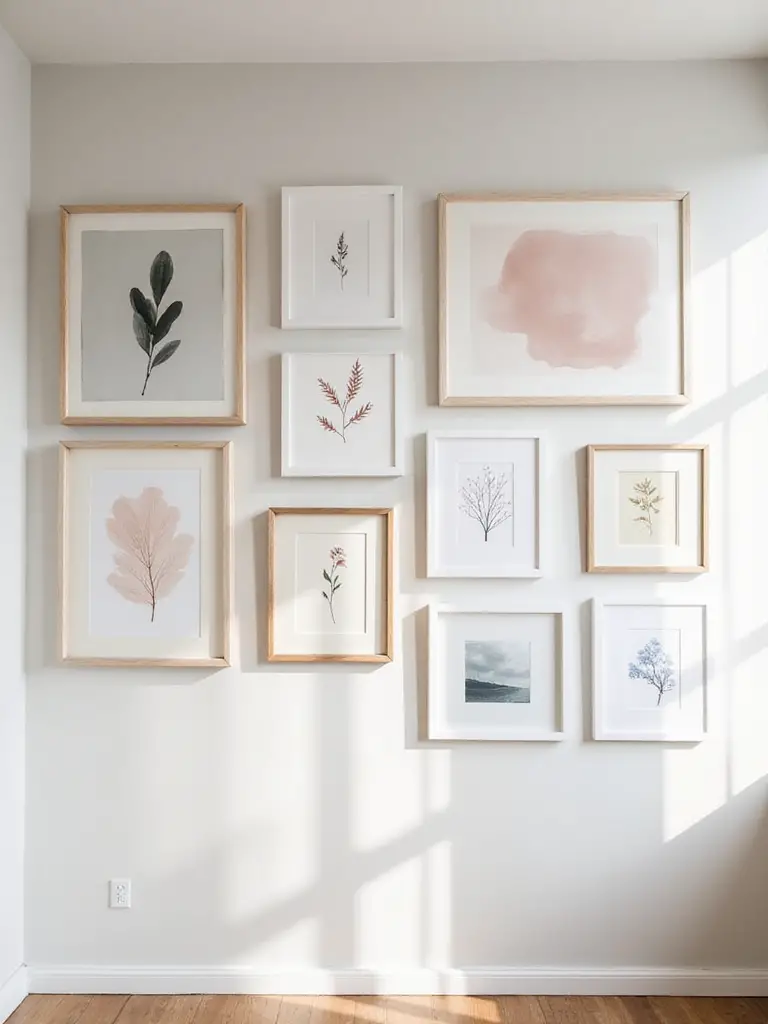
When selecting pieces for your dreamy gallery wall, look for that subtle common thread—perhaps a color palette or theme like “gentle skies” or “calm nature.” While mixing different mediums like photographs, illustrations, and textiles creates visual interest, ensure they share tonal qualities or thematic connections. Varying frame styles adds character, but limiting finishes helps maintain cohesion. Don’t hesitate to include non-traditional items like pressed flowers in glass or small decorative objects to add layers and a personal touch.
“The artisans behind these designs began with the concept of sanctuary—each piece in this collection speaks to the need for visual rest in our most intimate spaces.”
The inspiration for this collection struck when I realized how gallery walls could tell our personal stories while still maintaining the serenity essential for rest.
2. Choosing Your Perfect Single Statement Piece
A statement piece serves as the artistic anchor of your bedroom art aesthetic, chosen specifically for its ability to immediately capture attention and define the room’s mood. Unlike smaller works that contribute to a larger arrangement, a statement piece is typically substantial in scale and boasts compelling subject matter, bold colors, unique texture, or a striking composition. Its purpose is singular: to be the main focal point, drawing the eye and setting the tone for the entire space.
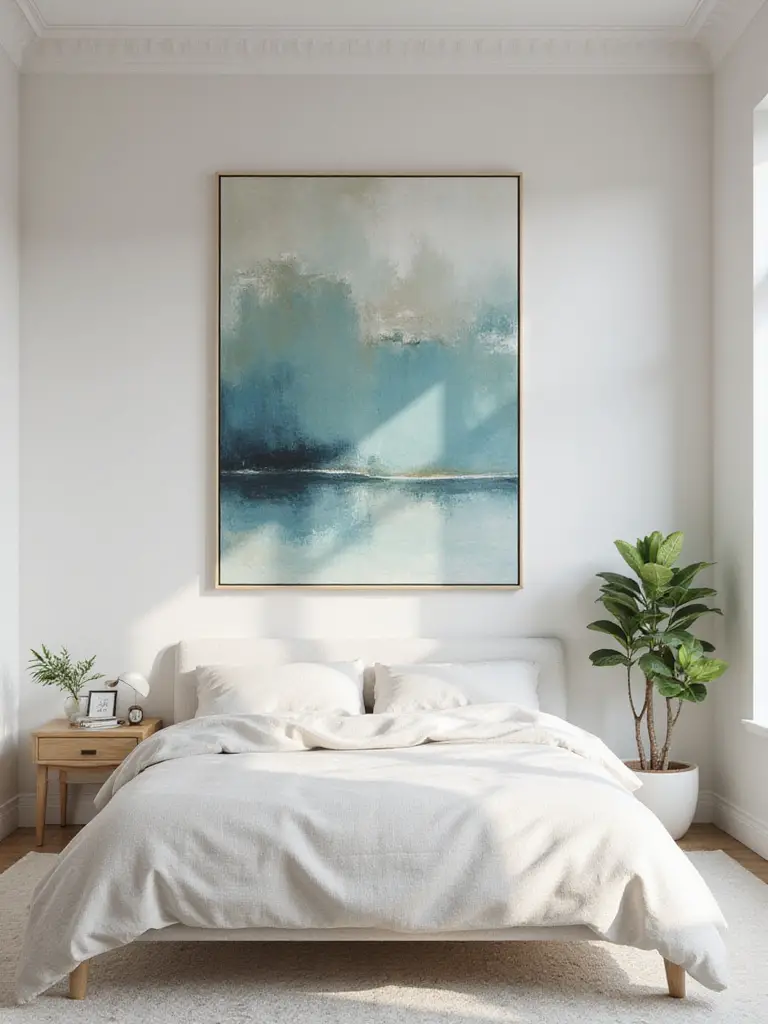
The most impactful placement for a statement piece is often directly above the headboard, as this wall naturally forms the visual center of the room, aligning with the bed as the central furniture piece. Alternatively, a large wall opposite the bed allows the art to be appreciated from a distance. When selecting size, aim for the art to occupy roughly two-thirds to three-quarters of the width of the furniture below it, ensuring it feels substantial without overwhelming. While perfect matching isn’t necessary, the piece should complement your existing decor and align with your desired mood—whether that’s energizing, calming, or somewhere in between.
- Use a single, oversized abstract painting with dynamic composition to inject personality into a minimalist bedroom design
- Consider art with subtle texture that changes appearance as natural light shifts throughout the day
- Look for pieces that spark conversation but still promote relaxation
What makes this design special is the way it anchors the room while still allowing other elements to breathe, creating a bedroom art aesthetic that feels both intentional and effortless.
3. Making an Impact with Art Above the Bed
The area directly above the bed represents the most significant wall space in a bedroom. As the eye naturally gravitates toward the bed, placing art here ensures it becomes a central element of the room’s design. This prime location allows you to establish a strong visual anchor, defining the style and mood of your sanctuary and creating a sense of completeness above the room’s largest piece of furniture.
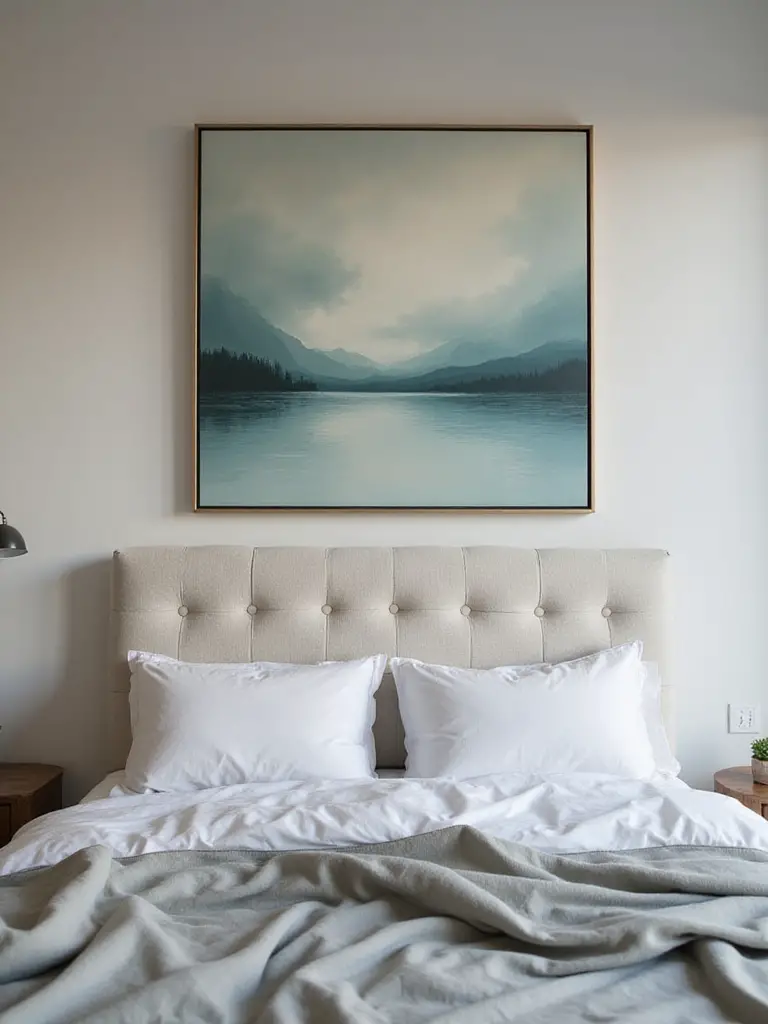
When selecting and hanging art above the bed, consider scale, style, security, and height. The artwork needs to be proportionate to the bed’s width, typically covering two-thirds to three-quarters of the headboard or bed frame. Choose pieces that promote calm or inspiration, aligning with the bedroom’s purpose. Security is paramount—ensure the art is properly mounted using appropriate hardware, especially if it’s heavy. Position the art so its bottom edge sits roughly 6-8 inches above the headboard, creating a visual connection without obstruction.
The challenge of awkward spaces becomes easier when you see the wall above your bed not as a problem but as a canvas for expressing your unique bedroom art aesthetic.
4. Smart Art Solutions for Cozy Corners
Decorating a cozy bedroom corner presents a different challenge than filling a large wall. Limited space requires art that’s scaled appropriately, enhancing intimacy without overwhelming the confined area. The art should complement nearby furniture and lighting, contributing to a harmonious retreat rather than creating visual clutter. It’s about crafting a personal moment within a defined, comfortable space.
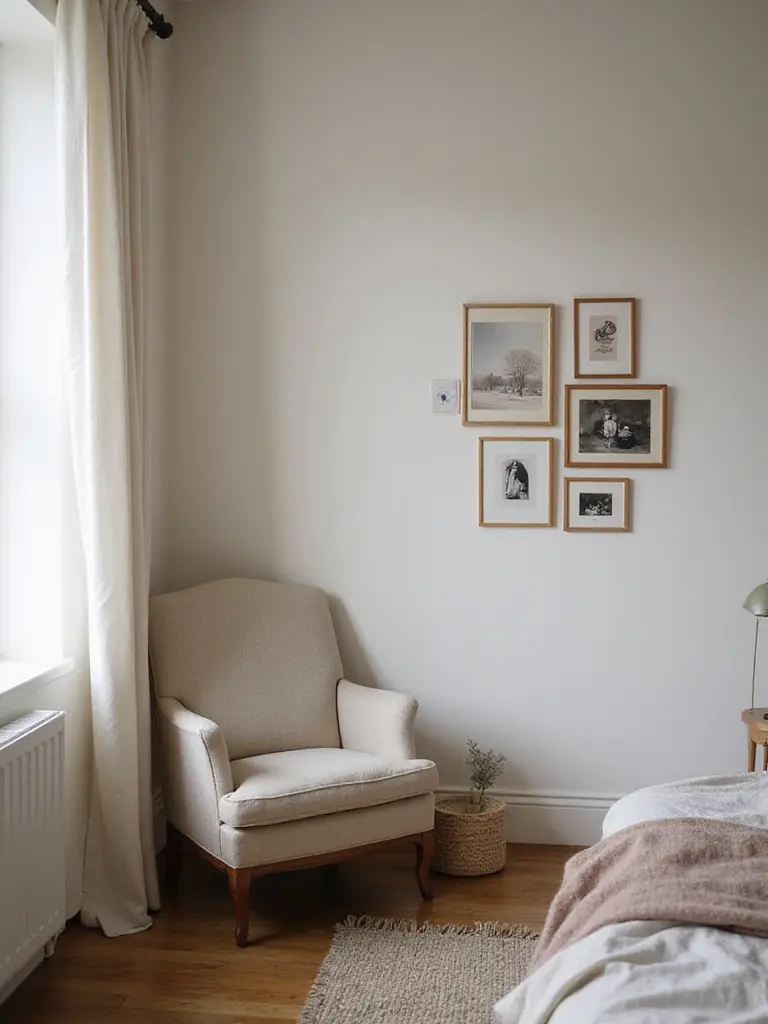
Small, intimate corners showcase smaller-scale art that might get lost elsewhere. Consider curated clusters of small framed prints, vertical arrangements that draw the eye upwards, or single pieces perfectly proportioned to the wall space. Framed textiles, illustrations, or personal mementos work beautifully here. The art becomes a focal point, infusing the corner with personality and adding visual warmth through color and texture, making the nook feel more inviting and intimate—a true sanctuary for relaxation.
Designer's Secret: Professional stylists approach corner art by first considering the visual weight of nearby furniture, then choosing pieces that create balance rather than competition.Beyond the obvious placement, consider using these corner art arrangements to create transition zones between different areas of your bedroom, guiding the eye naturally through the space.
5. Filling Expansive Walls with Style
Large bedroom walls can feel overwhelming. A single small piece looks lost, emphasizing the wall’s vastness, while poorly chosen large pieces can dominate uncomfortably. The key lies in selecting art that’s proportional to both the wall and room, creating a balanced focal point that enhances your bedroom art aesthetic rather than disrupting it.
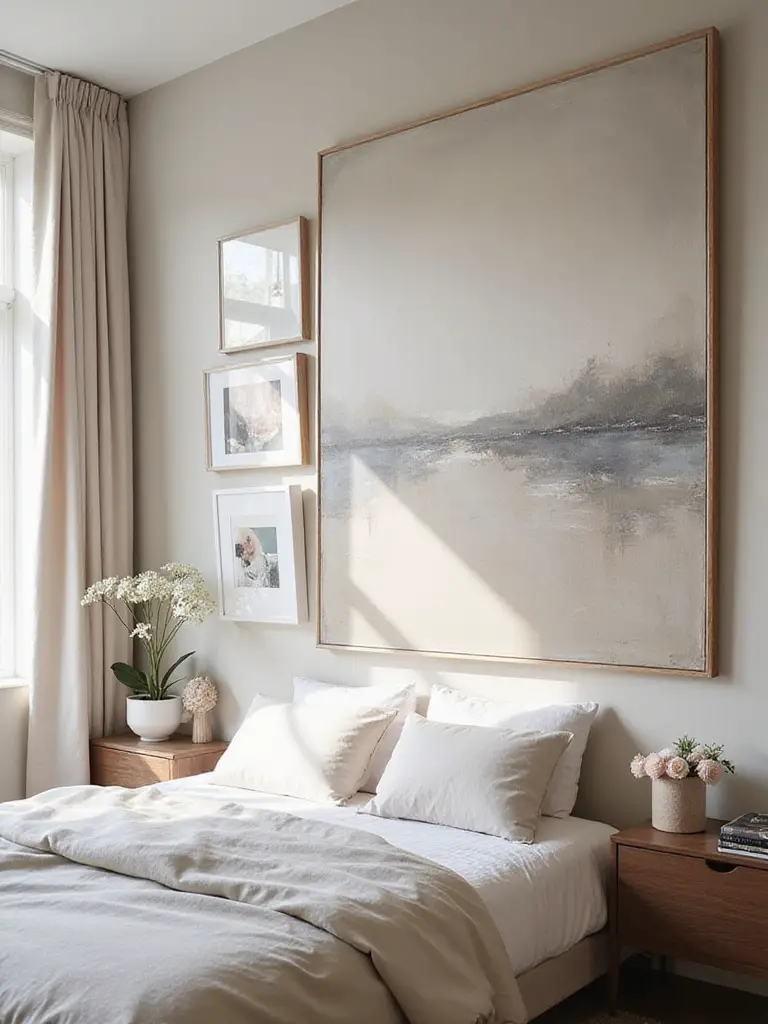
Effective strategies include investing in a single, oversized statement piece, creating a curated gallery wall that spans a significant area, or incorporating large-scale treatments like murals or tapestries. Combining art with decorative shelving or mirrors also helps break up the space while adding functionality. Whatever approach you choose, ensure it feels intentional rather than like a hasty attempt to fill empty space.
- Measure your wall space carefully before selecting art
- For gallery walls, use painter’s tape to experiment with layouts before making holes
- Consider the viewing distance—larger walls often require bolder pieces visible from across the room
The unexpected environmental benefit comes from thoughtfully filling these large spaces—properly scaled art eliminates the urge to accumulate numerous smaller pieces that might otherwise end up as future waste.
6. Harmonizing with Matching Art Sets or Diptychs
Matching art sets or diptychs (sets of two pieces) are designed to be displayed together, offering an immediate sense of balance and visual harmony. Their coordinated elements—shared colors, themes, or styles—provide a cohesive look that feels calming and intentional, ideal for enhancing your bedroom art aesthetic. Unlike disparate collections, these sets reduce visual clutter and promote a feeling of order that supports restful sleep.
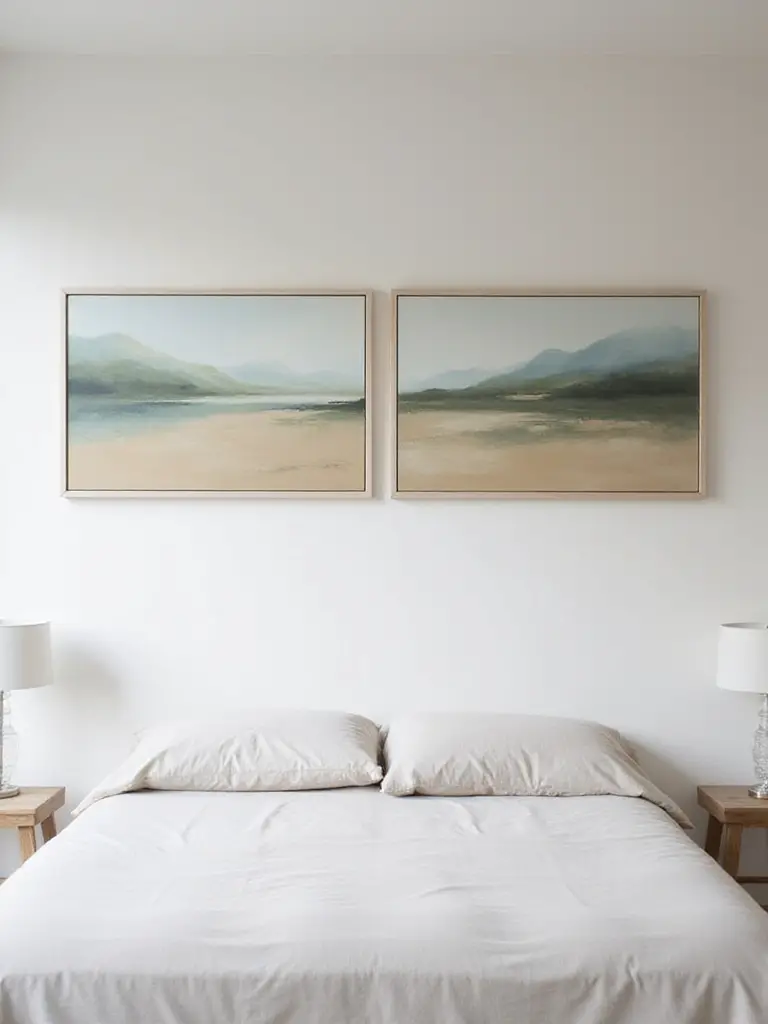
These coordinated pieces powerfully reinforce a specific mood or style direction. Choosing a set with a particular aesthetic (minimalist, botanical), color palette (serene blues, soft pastels), or theme (coastal, abstract texture) enhances your bedroom’s design identity. The repetition or continuation of visual elements strengthens the impact of your chosen style, contributing to a feeling of stability and calm essential for a bedroom environment. Consider the space between pieces—typically, 2-6 inches works well to visually connect them without crowding.
“The interplay between the colors creates a visual rhythm that guides the eye naturally across the wall, offering both movement and rest.”
While designed for the living room, we’ve seen creative uses of diptychs and triptychs in bedrooms where they create a sense of expansiveness above the bed or on adjacent walls.
7. Adding Intrigue with Abstract Creations
Abstract art adds a layer of intrigue to your bedroom art aesthetic by inviting personal interpretation. Without depicting recognizable subjects, it allows viewers to connect based on emotions and perspectives, creating a subtle sense of mystery perfect for a private space like a bedroom. The interplay of colors, shapes, textures, and lines can evoke specific moods and feelings, making the piece a dynamic point of interest that shifts with changing light or your own state of mind.
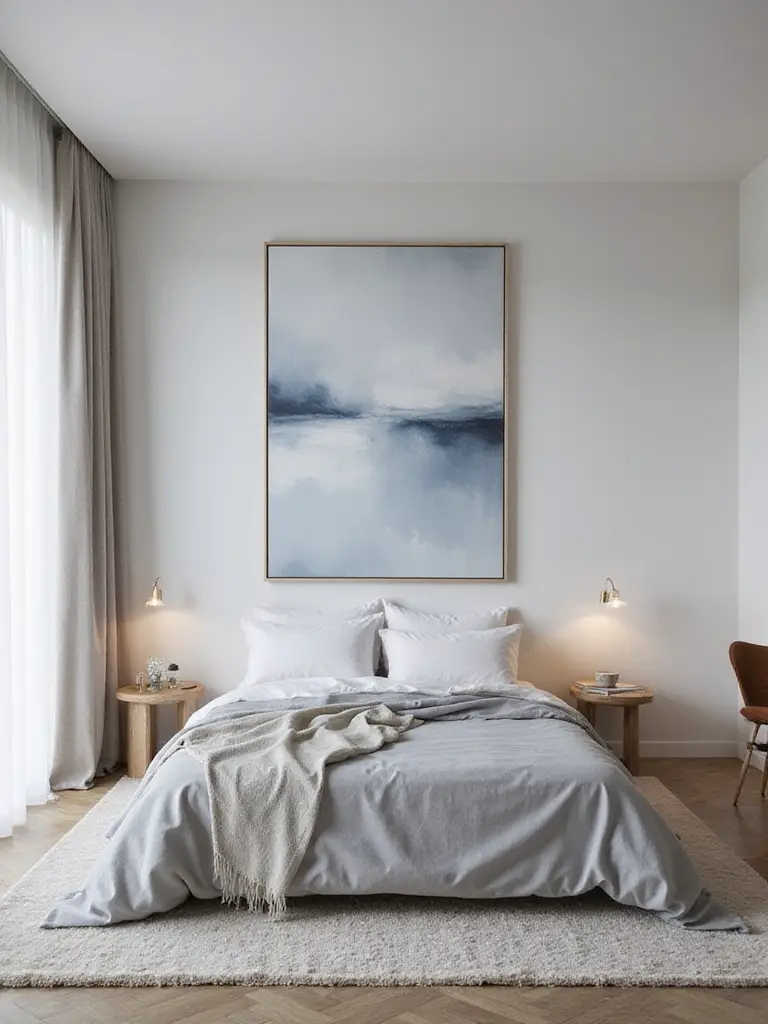
What surprises clients most is how abstract art fits seamlessly into diverse bedroom styles. In minimalist spaces, a clean abstract piece with limited color adds interest without clutter. For modern rooms, bold abstracts provide energy and personality. Bohemian bedrooms benefit from layered, textured abstracts with organic shapes and warm tones. The key is choosing a piece whose elements align with your desired style and mood, whether that’s calm tranquility, gentle energy, or serene contemplation.
The versatility reveals itself when you pair abstract art with different bedroom elements—it can complement architectural features, echo textile patterns, or provide counterpoint to more structured furniture pieces.
8. Embracing Serenity with Minimalist Art
Minimalist art is defined by its essential simplicity, featuring limited elements, clean lines, and restricted color palettes, often with generous negative space. It focuses on form, line, or subtle texture rather than detailed narratives, typically using muted or monochromatic colors like whites, grays, earth tones, or soft pastels. The goal is to soothe and provide visual calm, not to stimulate or overwhelm—perfect for enhancing a peaceful bedroom art aesthetic.
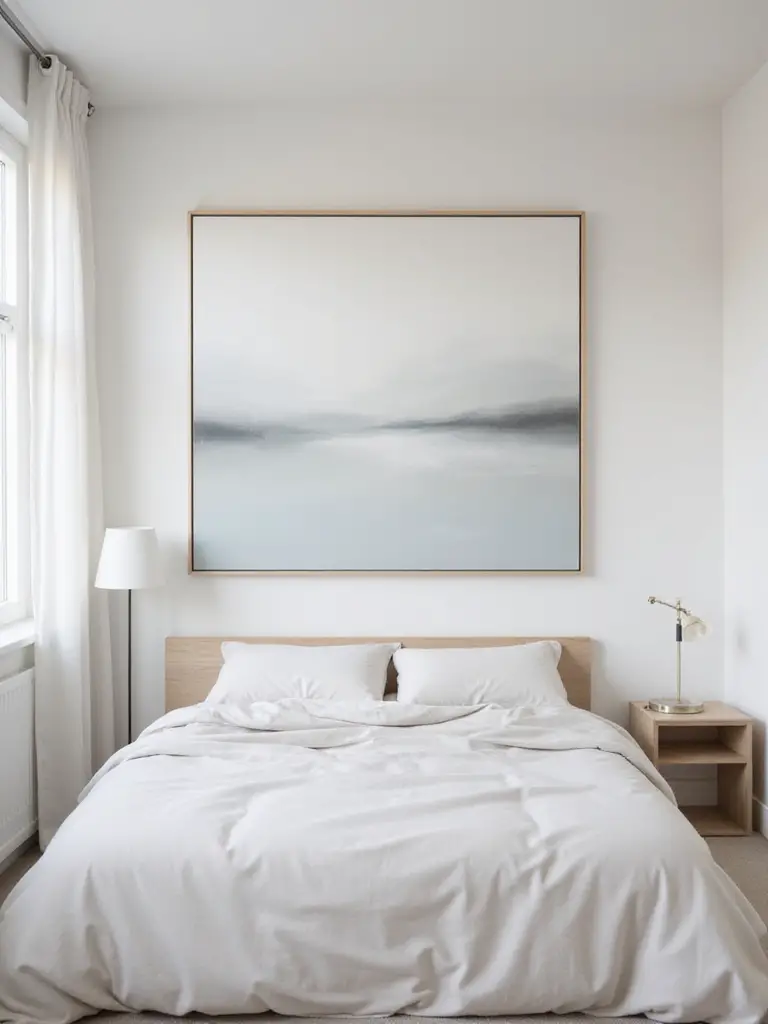
This approach promotes serenity by reducing visual noise in a space meant for rest. Where complex art can be mentally engaging or even distracting, minimalist art allows the mind to quiet. Its simplicity and negative space provide a sense of openness and breathing room, while limited palettes and simple forms evoke calm and stability. These pieces serve as grounding focal points that aid relaxation and prepare the body and mind for sleep, functioning almost as visual meditation.
- Choose pieces with ample negative space to create visual breathing room
- Look for subtle texture variations that add interest without complexity
- Consider monochromatic works that create depth through tonal variations rather than color contrasts
For those hesitant about bold patterns or colors, minimalist art offers a sophisticated way to enhance your bedroom art aesthetic without overwhelming the senses.
9. Capturing Moments with Photography Prints
Photography prints offer a unique, personal dimension to your bedroom art aesthetic. They capture real-world moments, places, or emotions, creating an immediate connection, especially with personal photos. This resonance adds comfort and intimacy, making the space feel truly yours. Photography’s versatility in style (from dramatic black and white to soft, dreamy color) and presentation (various print materials and framing options) allows it to complement virtually any decor style.
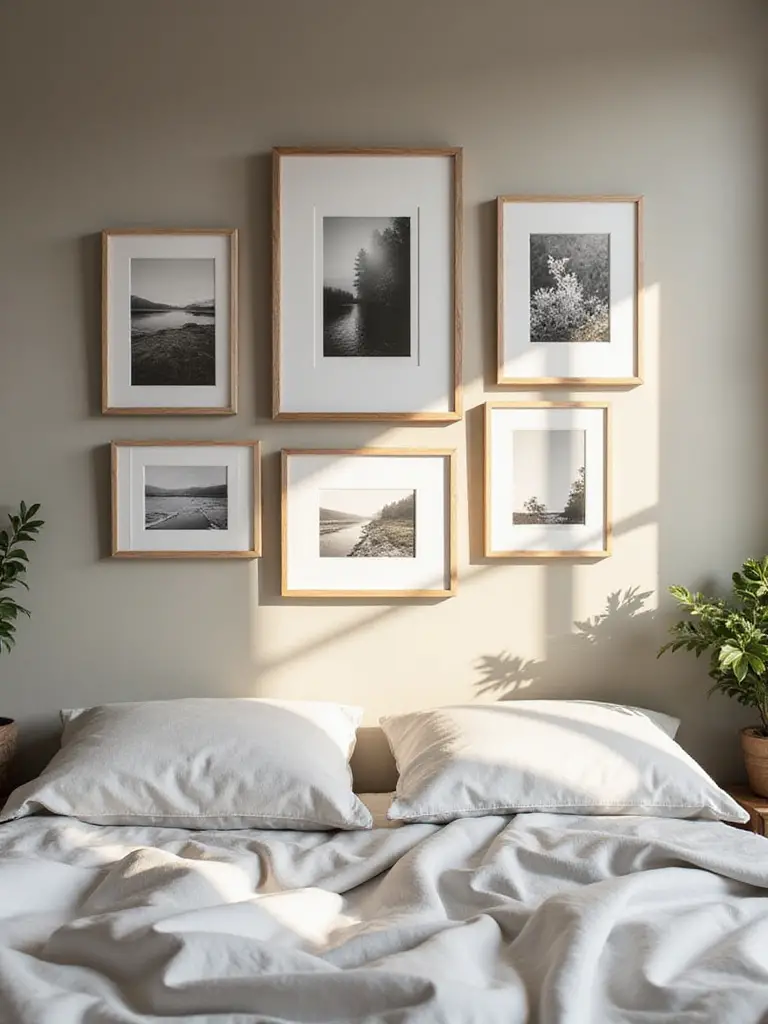
For bedrooms specifically, photography that evokes positive emotions or tranquility works best. Nature and landscape photography, soft-focus or abstract prints, or timeless black and white images contribute to a calming atmosphere. Personal photographs add warmth and memory, but should be thoughtfully curated and tastefully displayed to avoid creating visual clutter. Selecting high-quality images and consistent presentation styles (like matching frames or printing in a uniform tone) helps incorporate personal photography effectively into your bedroom art aesthetic.
Pro Tip: When using personal photos in your bedroom, convert them to black and white or sepia for a cohesive, timeless look that won't compete with your color scheme.Many homeowners wonder how to balance personal photos with more artistic pieces—the secret lies in treating your photographs as art in their own right, giving them proper framing and placement rather than simply hanging snapshots.
10. Bringing Nature Indoors with Botanical Beauties
Botanical art, in its various forms, perfectly complements a bedroom art aesthetic due to its inherent ability to evoke calm and tranquility. This category includes detailed scientific illustrations, vintage botanical prints, pressed flower art, abstract interpretations of natural forms, or macro photography of plants. The key is selecting pieces that connect to nature without being overly vibrant, often featuring softer palettes and intricate natural textures.
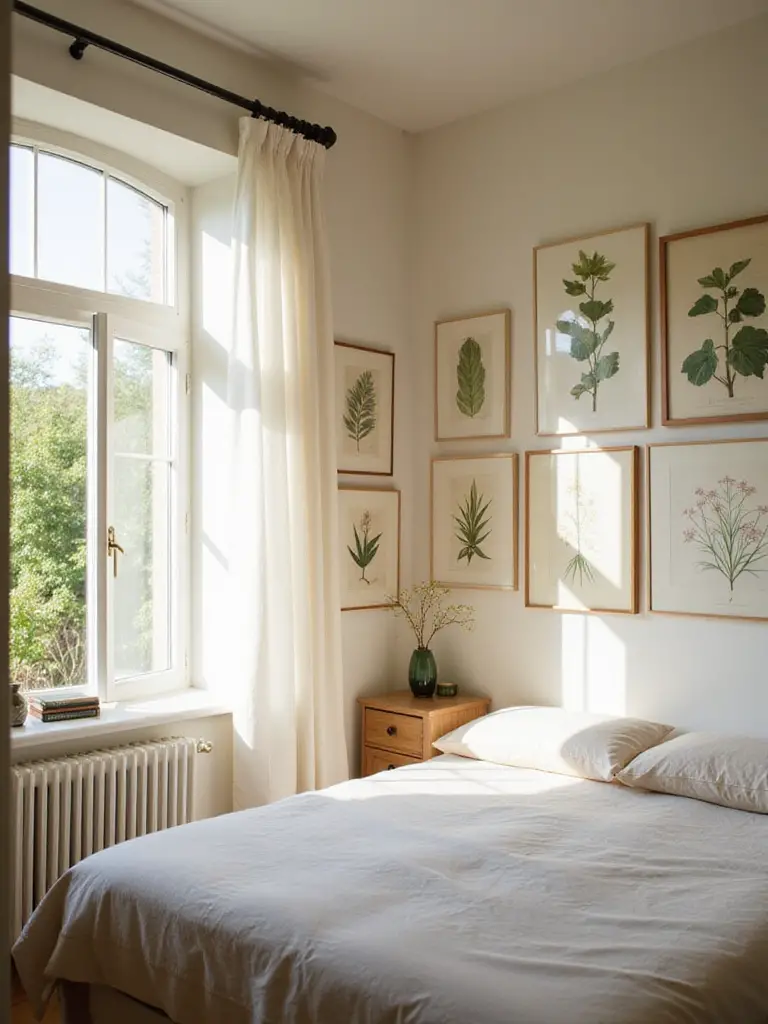
Incorporating botanical art significantly enhances a bedroom by introducing organic shapes and soothing colors derived from the natural world. It softens architectural lines and adds visual interest through the intricate details found in leaves, flowers, or branches. More importantly, botanical art taps into biophilia—our innate human desire to connect with nature. This connection is linked to reduced stress and improved well-being, creating a more restful and rejuvenating atmosphere ideal for sleep and relaxation, serving as a serene visual escape within your private sanctuary.
- Create a gallery wall mixing framed botanical prints, pressed flowers, and nature-inspired sketches
- Look for botanical pieces that reflect seasonal changes to keep your bedroom feeling fresh year-round
- Consider vintage botanical illustrations for a timeless, scholarly aesthetic
The ecological story behind botanical art began centuries ago with scientific documentation, but today it serves as a gentle reminder of our connection to the natural world, even in our most intimate spaces.
11. Adding Texture with Textile Art & Tapestries
Textile art introduces a unique element to your bedroom art aesthetic: genuine texture. Unlike flat art forms, woven hangings, tapestries, macrame, or framed fabric pieces have physical depth and fibers that add visual interest and tactile quality. This texture contributes significantly to a sense of warmth, softness, and coziness, making the bedroom feel more inviting and comfortable. Beyond aesthetics, textiles can also help absorb sound, creating a quieter, more peaceful environment conducive to rest.
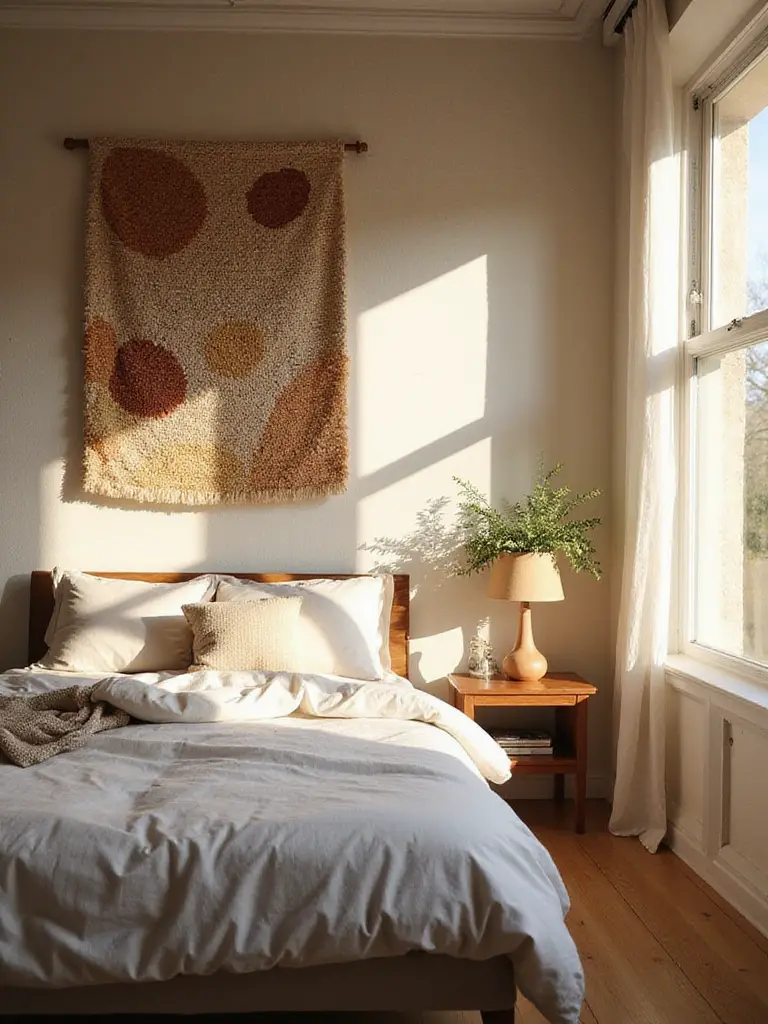
The range of textile art suitable for bedrooms is impressively diverse. Traditional tapestries offer historical richness and narrative, while modern woven hangings feature varied textures and abstract designs. Macrame brings a bohemian or naturalistic feel, and framed fabric pieces offer accessible ways to add pattern and texture. Your choice depends on your desired aesthetic—a classic tapestry for traditional elegance, a chunky weave for modern bohemian style, or minimalist macrame for contemporary spaces. Consider scale and placement carefully; a large piece can serve as a soft focal point above the bed, while smaller pieces work well in gallery walls or intimate nooks.
Running your hand across this material reveals the care and craftsmanship behind each piece—something that mass-produced prints simply cannot offer to your bedroom art aesthetic.
12. Framing Your Favorite Posters with Flair
Framing transforms a simple poster into an intentional piece of art within your bedroom aesthetic. It adds sophistication, visual weight, and crucial protection from damage and fading. A well-chosen frame complements the poster’s style and colors, ties it into your room’s decor, and creates a polished look that shows you value the image as a significant decorative element rather than a temporary addition.
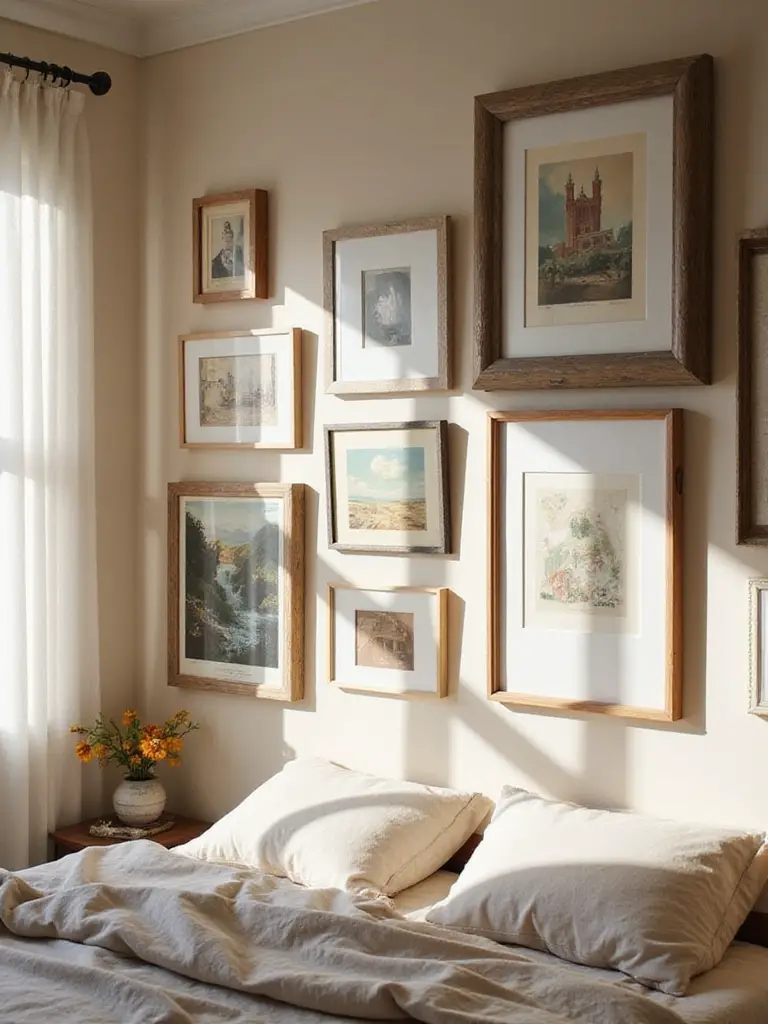
Elevating poster framing goes beyond basic black frames. Using acid-free mats adds depth and visual breathing room, making even standard-sized posters feel more substantial and gallery-worthy. Explore different frame materials and finishes—distressed wood for vintage pieces, metallics for modern art, or colored frames that pick up accent hues from your bedroom. Non-traditional methods like floating frames, magnetic hangers, or wooden rails offer contemporary alternatives. Grouping framed posters in a curated gallery wall adds personality and visual interest, especially when unified by theme, color, or frame style.
- Use oversized mats (especially white or cream) to give standard posters a high-end, custom look
- Consider float mounting posters with unique edges or those you don’t want to trim
- Match frame finishes to other metal elements in your bedroom for cohesion
The craftsmanship reveals itself in details like perfectly mitered corners and properly secured backing—elements that transform everyday images into lasting components of your bedroom art aesthetic.
13. Curating Character with Vintage Finds
Incorporating vintage art into your bedroom brings a unique sense of history, character, and individuality that mass-produced pieces often lack. Each vintage item tells a story, adding depth and personality to your bedroom art aesthetic while preventing it from feeling generic or catalog-ordered. These finds introduce unique color palettes, aged textures, and styles from different eras, offering a sustainable way to decorate by giving new life to pre-loved objects.
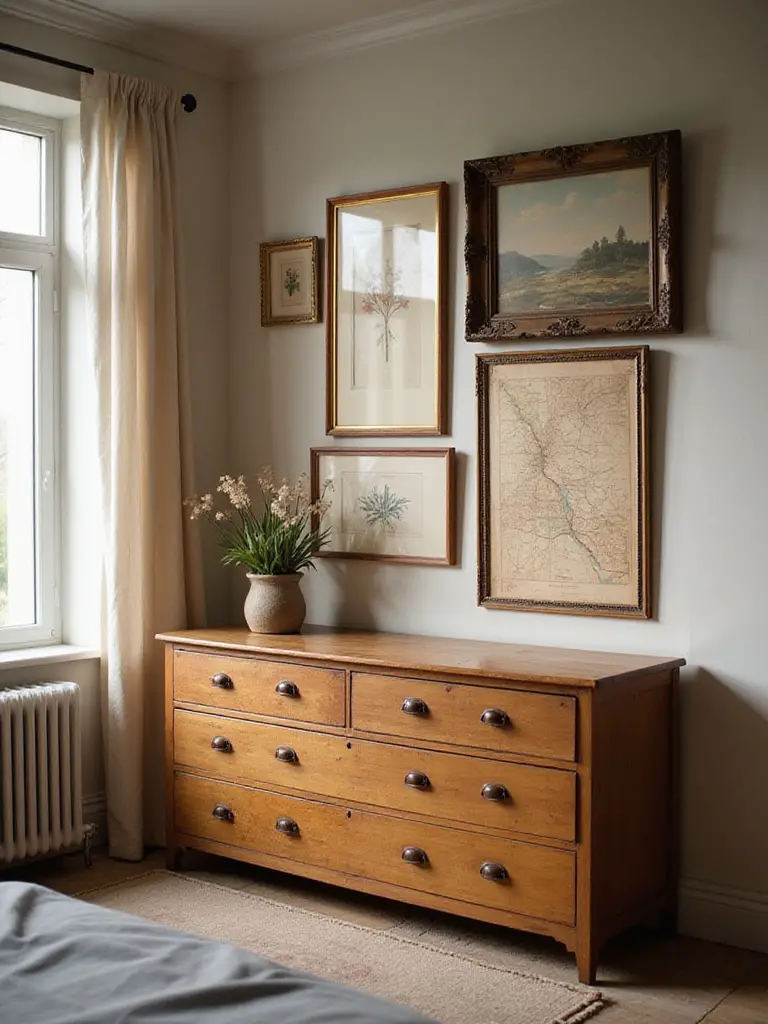
For a bedroom setting specifically, look for vintage art that feels personal, calming, or inspiring. This might include framed botanical prints, antique maps of places you love, old portraits with intriguing expressions, landscapes with soft colors, framed vintage textiles, or even beautifully composed vintage photographs. Seek pieces with softer colors, intriguing details, or a sense of tranquility. The frame itself, if vintage, can add significantly to the piece’s character and impact. Excellent hunting grounds include antique shops, thrift stores, estate sales, flea markets, and online marketplaces—though finding the perfect pieces requires patience and regular searching.
The third-generation workshop where this type of art comes to life often passes down techniques that give vintage pieces their distinctive character—something worth considering as you build your bedroom art aesthetic around pieces with history.
14. Personalizing Your Space with DIY Art Projects
DIY art offers exceptional bedroom personalization because it allows you to create pieces that are genuinely unique and reflect your individual style, interests, and memories. You can perfectly match your decor’s color palette, use materials with personal significance, or depict themes meaningful to you alone. It’s a budget-friendly way to fill wall space with impact, and the process of creating is inherently rewarding, adding another layer of connection to your bedroom art aesthetic.
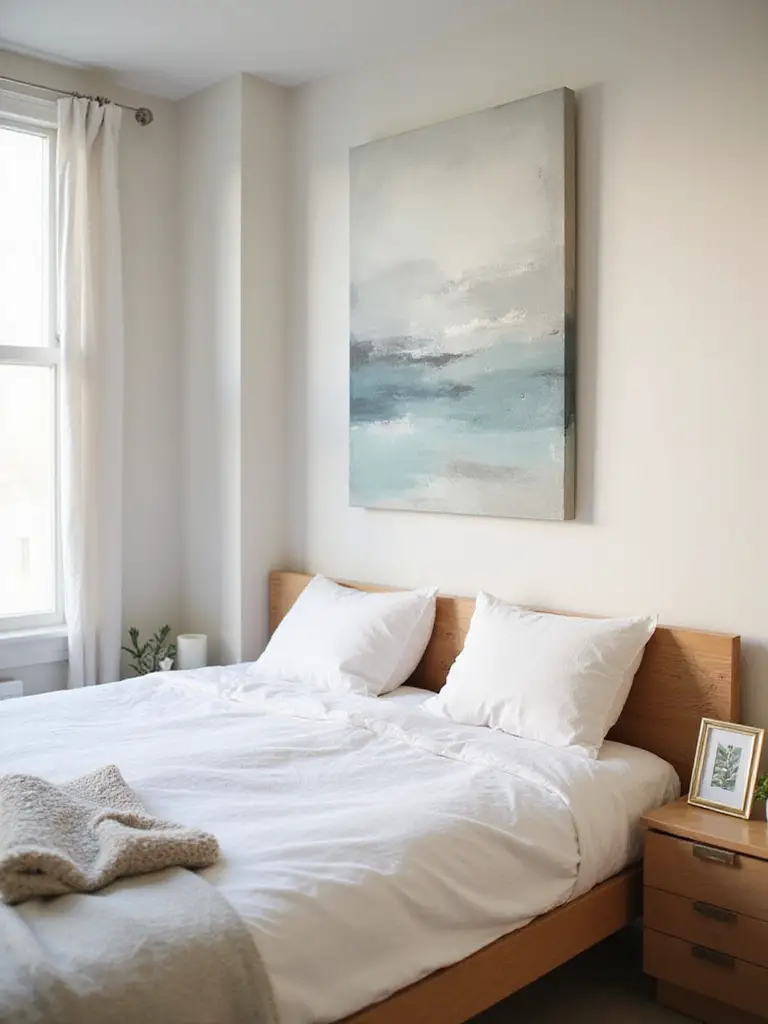
Several beginner-friendly DIY art projects can elevate your bedroom walls. Simple options include abstract painted canvases using color blocking or intuitive brushstrokes—no artistic experience required. Creating collages from magazines, books, or photos offers a deeply personal touch. Framing pressed flowers or botanical elements from your garden, fabric scraps with meaningful patterns, or even beautiful gift wrap adds natural or textural elements. String art or painting a simple quote in a complementary color are also accessible methods. The key is choosing techniques that feel approachable while focusing on color and composition to ensure the finished piece enhances your room.
“If you’ve struggled with similar rooms before, creating your own art allows you to address specific challenges—like awkward wall spaces or difficult color schemes—in ways that store-bought pieces rarely can.”
After months of sourcing and curation, many homeowners discover that their most treasured bedroom art pieces are often the ones they’ve created themselves, infused with personal meaning and perfectly tailored to their space.
15. Highlighting Your Pieces with Thoughtful Lighting
Thoughtful lighting is crucial for making your bedroom art aesthetic truly shine. Picture lights mounted directly above frames provide focused illumination for individual pieces, while track lighting offers flexibility to highlight multiple artworks from adjustable positions. Accent spotlights can precisely target pieces from a distance, and wall washers evenly illuminate larger works or gallery walls. For smaller pieces displayed on shelves, integrated LED lighting creates a museum-like effect.
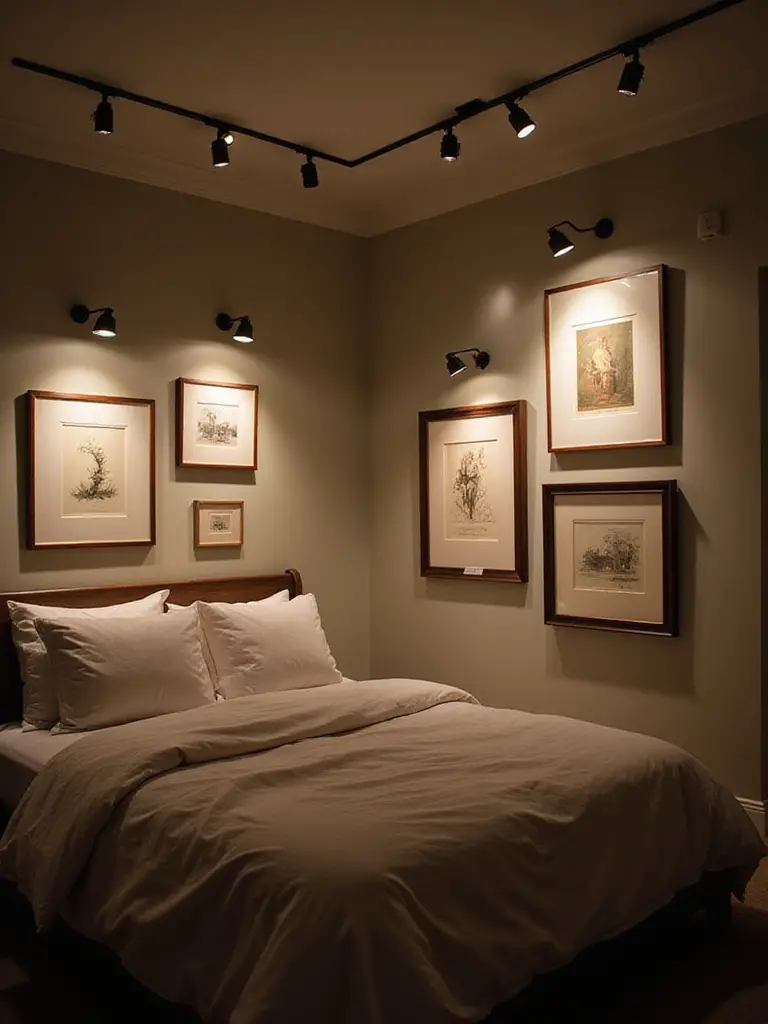
The type of light bulb significantly impacts how art appears and its longevity. High Color Rendering Index (CRI) bulbs (90+) ensure accurate color representation. Kelvin temperature dictates the warmth or coolness of light—2700K-3000K provides a cozy, intimate feel ideal for bedrooms. Modern LED bulbs are strongly preferred as they emit minimal heat and virtually no UV radiation, protecting art from damage over time, unlike traditional incandescent or halogen options. Avoid common mistakes like creating glare from improper angle positioning, casting harsh shadows, lighting unevenly, using low CRI bulbs that distort colors, or over-lighting, which can make the bedroom feel like a gallery rather than a restful space.
- Choose adjustable fixtures that allow you to refine the lighting angle as seasons change
- Consider dimmers to adjust lighting intensity from day to evening
- Look for fixtures with appropriate beam spread for your art size—narrow for small pieces, wider for large works
The ambiance evolves throughout the day as natural light shifts, making thoughtful artificial lighting essential for maintaining your bedroom art aesthetic after sunset.
16. Using Mirrors to Reflect Style and Light (as art)
Mirrors function beautifully as art in a bedroom when chosen and placed with intention, transcending their practical purpose. Their frames become artistic elements themselves, ranging from ornate vintage designs to sleek contemporary styles. The mirror’s shape adds significant artistic value—whether circular, asymmetrical, or architectural—and its strategic placement dictates what it reflects, effectively incorporating other parts of the room or outside views into the visual composition, adding depth and dimension. A thoughtfully arranged collection of mirrors can create a dynamic gallery wall, transforming a simple bedroom wall into a captivating display.
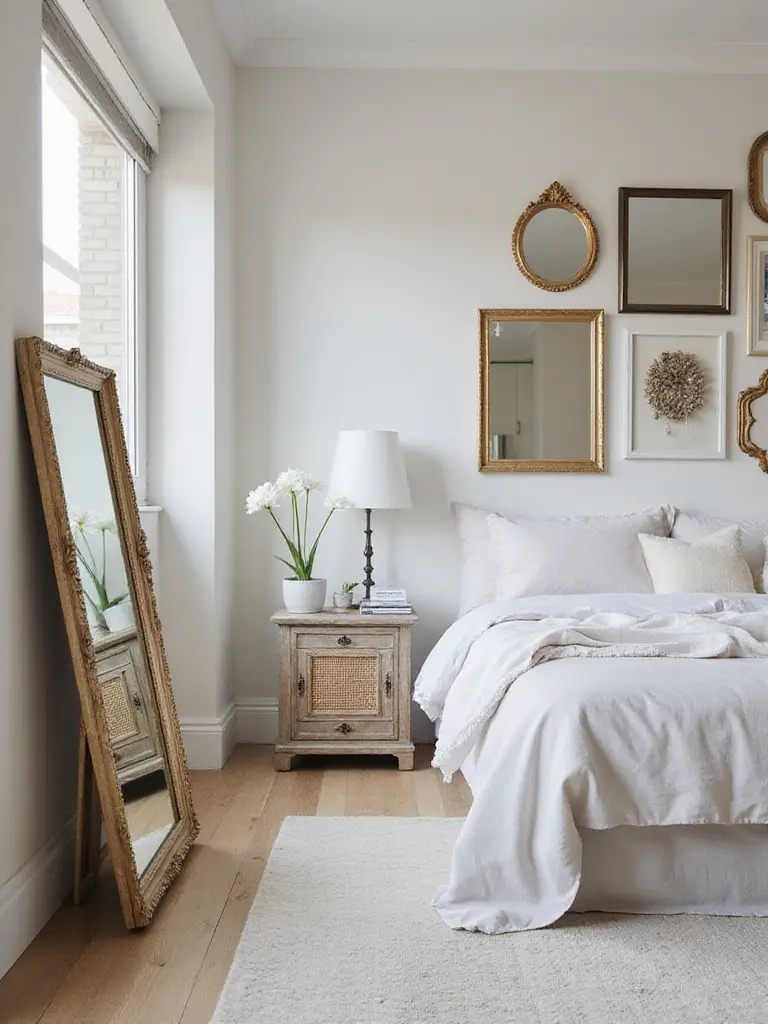
Incorporating mirrors artistically offers several key benefits for your bedroom art aesthetic. They excel at bouncing light around the room, making the space feel brighter and more open—particularly helpful in bedrooms lacking abundant natural light. They create an illusion of increased space, making even small bedrooms feel larger and more airy. By reflecting elements within the room or views from windows, they add visual interest and depth, essentially ‘framing’ these reflections as part of your decor. Remarkably versatile in design, mirrors complement virtually any aesthetic, functioning simultaneously as practical pieces and significant decorative statements.
As morning light filters through your curtains, the texture and reflective qualities of artfully placed mirrors create an ever-changing display that brings your bedroom art aesthetic to life in ways static pieces cannot.
17. Coordinating Art with Your Room’s Color Scheme
Coordinating bedroom art with your color scheme creates a sense of harmony, balance, and intention. Art is a powerful visual element, and when its colors relate to the existing palette—whether by matching, complementing, or contrasting strategically—it helps the room feel cohesive and thoughtfully designed. This prevents the art from looking disconnected and ensures every element contributes to your desired mood, making your bedroom art aesthetic more polished and inviting.
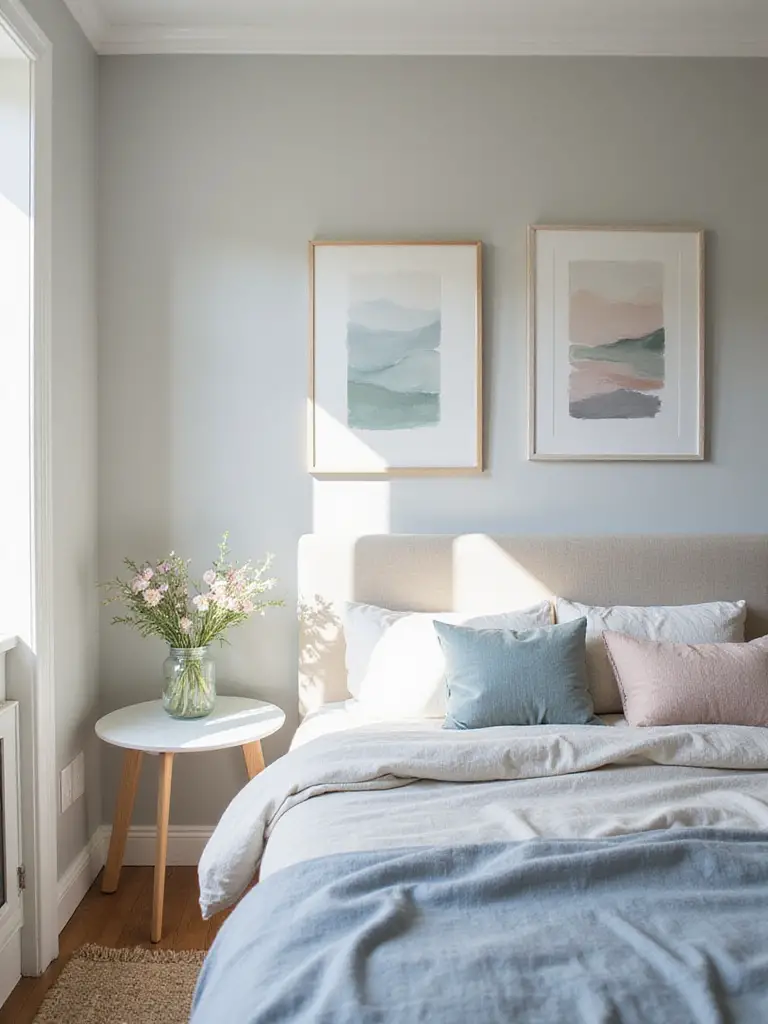
Different approaches to color coordination offer varying effects. You might choose art that incorporates dominant or accent colors already present in your bedroom for immediate harmony. Using color wheel principles, you can select art with complementary colors (opposite on the wheel) for vibrant contrast or analogous colors (adjacent) for soothing harmony. Art can also introduce a new accent color, provided that color appears in small doses elsewhere to tie everything together. In a colorful bedroom, neutral art can act as a grounding element, while in a neutral room, it maintains the calm aesthetic or provides subtle contrast.
Designer Tip: Take photos of your bedroom in different lighting conditions and carry fabric swatches when art shopping to ensure colors work harmoniously throughout the day and night.The color story development process often begins with finding that perfect piece of art—many successful bedroom art aesthetic schemes start with a favorite artwork that inspires the entire room’s palette.
18. Setting the Mood with Emotion-Evoking Art
Art has a profound ability to evoke specific emotions, making it a powerful tool for setting the mood in your bedroom sanctuary. Color plays a significant role—cool blues and greens promote calmness, while warmer tones add intimacy or subtle energy. Subject matter is equally crucial—peaceful landscapes or gentle abstracts evoke tranquility, while dynamic pieces might encourage introspection or creativity. The style and technique also contribute significantly—soft, blurred forms feel dreamy and serene, while sharp lines and high contrast can be more stimulating. Ultimately, the emotional impact is a personal interaction between you and the art, making it essential to choose pieces that genuinely resonate with your desired bedroom feeling.
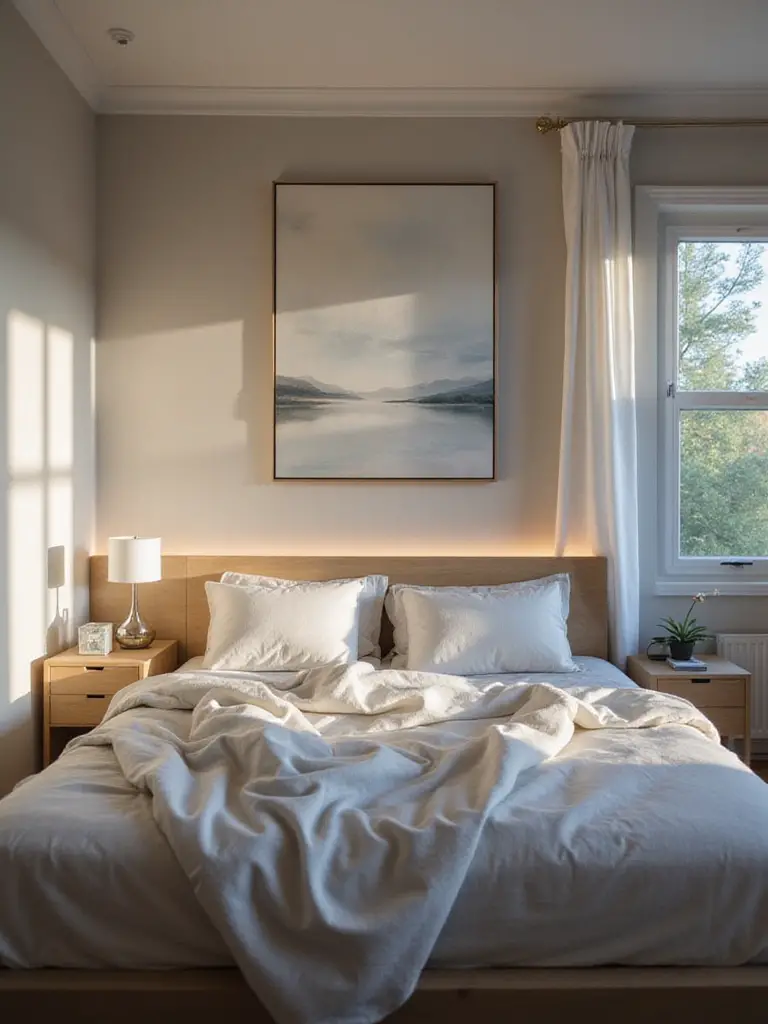
Bedrooms are spaces for rest, relaxation, intimacy, and reflection, making emotions like serenity, peace, comfort, and gentle inspiration ideal for your bedroom art aesthetic. To cultivate these moods, consider art with naturally calming subjects like tranquil landscapes, seascapes, or nature scenes; abstract art with muted, harmonious palettes; or minimalist pieces with ample negative space. For romance or intimacy, explore expressive abstracts with warm colors or soft figurative studies. Textured art or pieces with warm color schemes can enhance comfort. The key is selecting art that personally makes you feel the desired emotion in your private space.
The emotional response this evokes begins with your initial reaction but deepens over time as the artwork becomes integrated into your daily rituals of waking and resting, becoming an essential element of your bedroom art aesthetic.
19. Styling with Leaning Art on Surfaces or the Floor
Choosing to lean art instead of hanging it offers several advantages for your bedroom art aesthetic. It provides tremendous flexibility, allowing easy rearrangement without damaging walls—perfect for renters or those who like to refresh their space frequently. Leaning creates a relaxed, casual aesthetic that feels effortlessly sophisticated and lived-in. It’s also a practical solution for displaying oversized pieces that might be challenging to hang securely, or for creating layers and depth on surfaces like dressers or shelves.
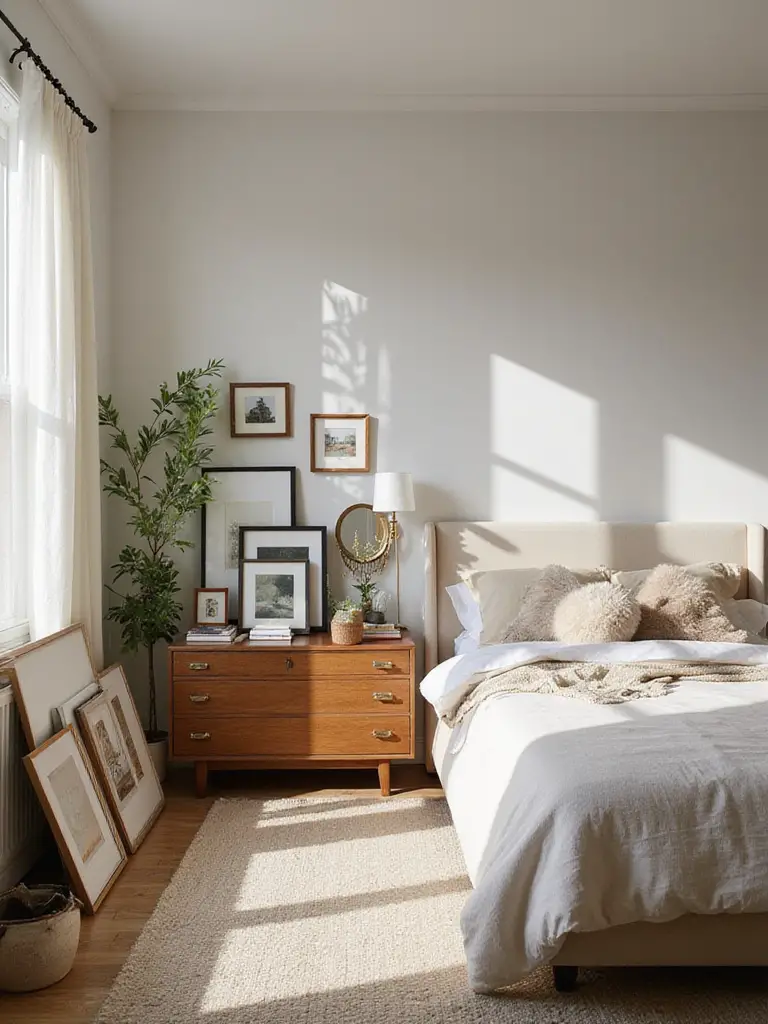
Leaning art works effectively in several bedroom locations. Larger pieces look striking leaning on the floor against a wall, often positioned behind furniture like nightstands or dressers for protection. Dressers and chests provide ideal surfaces for leaning medium to small framed pieces, which can be layered with other decorative items for a curated vignette. Nightstands can accommodate smaller frames without overwhelming their functional purpose, and open shelving units are perfect for integrating leaned pieces into displays with books and objects. Almost any type of art or frame can be leaned, from traditional framed prints and canvases to mirrors and even unframed canvases for a studio-like feel.
- Layer multiple pieces of varying sizes on a dresser top for dimension
- Use small easels to prop up special pieces on nightstands
- Consider using a picture ledge for a more secure leaning display that still maintains the casual aesthetic
This chameleon-like approach adapts to various bedroom art aesthetic styles by allowing you to change your display without commitment—perfect for those who appreciate evolving their space over time.
Conclusion
Creating your ideal bedroom art aesthetic is a deeply personal journey that transforms your sleeping space into a true sanctuary. From dreamy gallery walls and impactful statement pieces to the serenity of minimalist art or the character of vintage finds, each approach offers a unique way to express your personality and enhance your well-being. Thoughtful lighting highlights your chosen pieces, while mirrors add dimension and expand your space. Coordinating colors ensures visual harmony, and selecting art that evokes specific emotions helps craft the perfect atmosphere for rest and rejuvenation.
The beauty of developing your bedroom art aesthetic lies in its flexibility—these 19 approaches can be combined, adapted, and personalized to suit your space, style, and the feeling you wish to create. Whether you prefer bold statement pieces or subtle, layered collections, art that reflects nature or abstract expressions of emotion, your choices contribute to a space that nurtures both body and mind. Let your bedroom walls tell your story, creating a private retreat that welcomes you at the end of each day and inspires you at the start of a new one.
